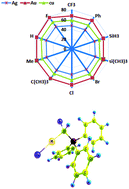N-Heterocyclic carbene or phosphorus ylide: which one forms a stronger bond with group 11 metals? A theoretical study†
Abstract
N-Heterocyclic carbene and phosphorus ylides are inorganic and organometallic ligands, and their coordination chemistry with transition elements, particularly group 11 metals, would be noticeable. This study seeks to characterize the structure and nature of the C→M bond of group 11 metals (M = Cu(I), Ag(I), Au(I)) in coordination with different monodentate phosphorus ylides {P(Ph)3CHR} and N-heterocyclic carbenes (NHC(R)) (where R = F, Cl, Br, CF3, CH3, H, C(CH3)3, Si(CH3)3, SiH3, Ph). In this regard, DFT calculations with the PBE/def2-TZVP level of theory were applied. The results show that the M←C bond interaction energies (ΔEint) related to [NHC(R) → MR′] and [{P(Ph)3CHR} → MCl] complexes (M = Cu(I), Ag(I), Au(I); R = F, Cl, Br, CF3, H, CH3, C(CH3)3, Si(CH3)3, SiH3, Ph; R′ = Cl, OAc) are substantial and conform to the well-known V-shaped trend for the transition metals of the first, second, and third row in the following order: Ag(I) < Cu(I) < Au(I). The nature of the C→M bond in the complexes was analyzed using NBO, AIM, EDA, and ETS-NOCV. The nature of the C→M bond interactions in [NHC(R) → MR′] and [{P(Ph)3CHR} → MCl] complexes studied here is largely electrostatic, and this feature accounts for about 65%–74% of the total interaction energy. Furthermore, it is found that in the presence of electron-donating substituents, the group 11 metals form stronger bonds with NHC(R) rather than monodentate phosphorus ylides. Comparison of the EDA-NOCV results for the M←C bond with the same M atom and R substituent in [NHC(R) → MR′] and [{P(Ph)3CHR} → MCl] indicates that the monodentate phosphorus ylide ligands studied here ({P(Ph)3CHR}) are slightly better σ-donors and weaker π-acceptors than the corresponding NHC(R) ligands.


 Please wait while we load your content...
Please wait while we load your content...